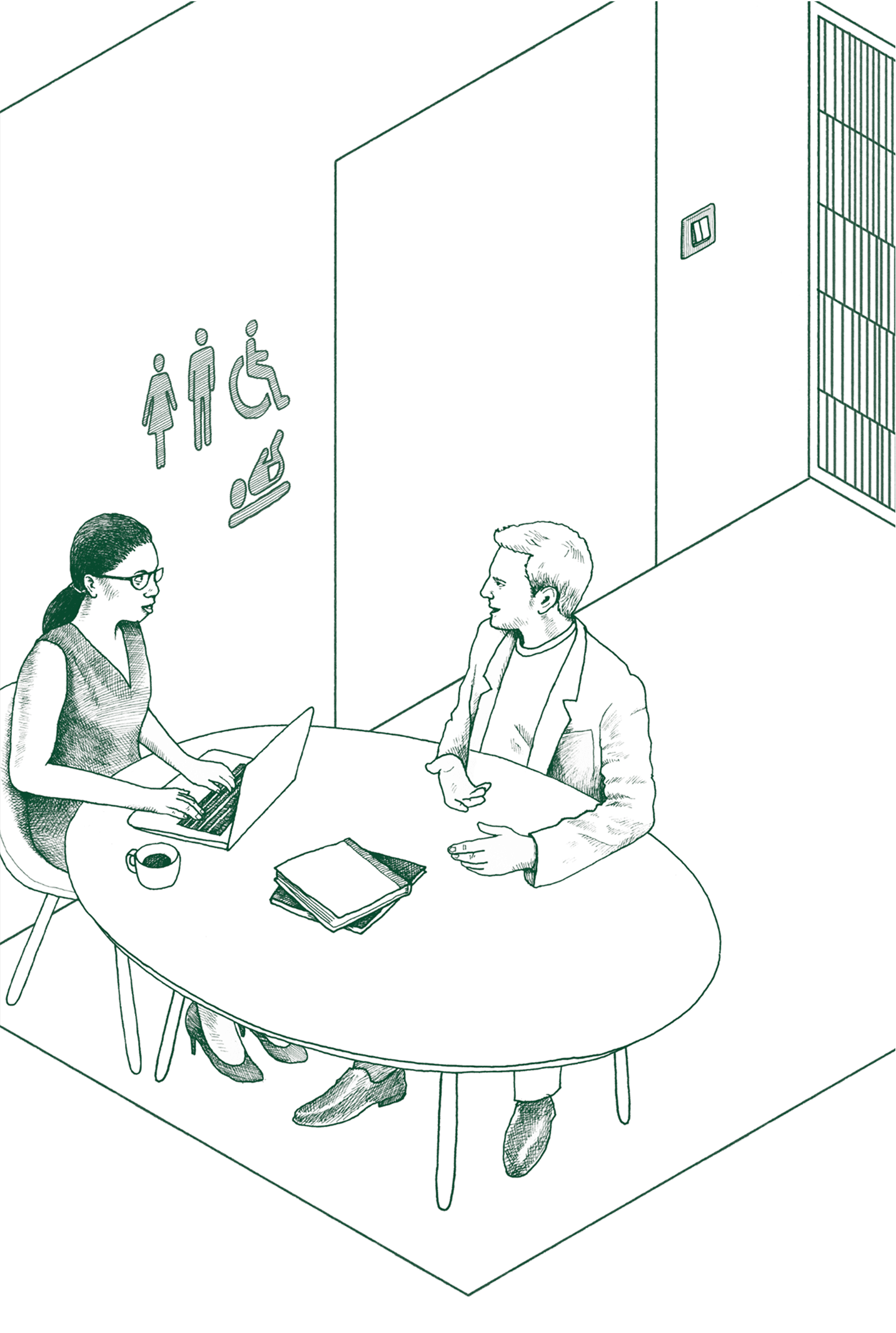Leveraging human-centered methodology
That’s 28 times the entire history of the U.S.
Prioritizing user needs isn’t a nice-to-have; it’s foundational to building efficient and effective systems that prevail for generations. By investing the time and resources to understand people’s needs, government agencies save on both in the long-term.
Building a trustworthy AI-enabled chatbot
Image caption
Nava Labs is building a human-centered and trustworthy AI chatbot by gathering feedback with caseworkers who help families find and enroll in public benefits.
Building a trustworthy AI-enabled chatbot
Nava Labs, the philanthropically funded arm of Nava, is prototyping and piloting an AI-powered assistive chatbot for caseworkers, call-center specialists, and community health workers — who we call “caseworkers” — to use when helping families find and enroll in public benefit programs. The Nava Labs team leveraged a number of tactics, like using hand-picked source material and providing direct-source citations, to improve the trustworthiness of the chatbot’s answers. This approach ensured the chatbot is human-centered, effective, accurate, and highly usable. By ensuring caseworkers can trust the chatbot, we’re helping connect potentially eligible people to critical benefits.
The Nava Labs team started by conducting extensive research with caseworkers and community partners to inform the project’s direction and chatbot details. This helped the team build trust with the caseworkers while ensuring they built a product that meets people’s needs. Then, the team designed the chatbot to write its responses based only on the specific documentation that caseworkers are trained on — like state-specific policy manuals — to reduce the likelihood of hallucinated answers.
The chatbot also provides direct-quote source citations for its summarized answers. This enables caseworkers to see the source material in context and ensure the answer’s accuracy — another safeguard against misleading summaries. If there’s an error, the Nava Labs chatbot allows caseworkers to give feedback on the quality of the answer. This enables the team to quickly address any issues and avoid similar problems in the future.
During the pilot, the caseworkers at partner organizations were not required to use the chatbot; instead they could try it on their own volition. If caseworkers continue using the chatbot, it’s because they think it’s trustworthy and helpful. This can also help the chatbot spread via word of mouth, with caseworkers who find it trustworthy recommending it to colleagues.
To learn more, read our case study.
Leveraging user research to deliver excellent paid leave services in Massachusetts
Image caption
We’re working with Massachusetts’ Department of Family and Medical Leave to conduct user research and improve applicant and employer experiences.
Leveraging user research to deliver excellent paid leave services in Massachusetts
Massachusetts’ Department of Family and Medical Leave (DFML) upholds user research as an efficient and effective way to ensure their paid family and medical leave (PFML) services meet the public’s needs. We’re supporting DFML as they conduct user research to help applicants understand which type of leave to apply for and to make it easier for eligible organizations to request an exemption from the state PFML program.
When a Bay Stater gives birth, they’re eligible for medical leave and family leave to bond with their child. However, some eligible applicants aren’t opting into both medical and family leave when they apply, which can create administrative burden for applicants and DFML staff.
To help applicants choose the correct type of leave when they apply, DFML is working with Nava to conduct usability testing on changes to the PFML application. With each round of testing, DFML is getting more targeted in ways to improve the application and ensure applicants get the leave they’re eligible for.
We’re also helping DFML update how employers request exemptions from the state PFML program. Previously, this experience was external to DFML’s systems. We’re helping DFML build and enhance the experience in their employer portal, which will improve experiences for employers and DFML staff.
DFML worked with Nava to run several rounds of usability testing and a pilot with employers and DFML staff. This process enabled DFML to gather early feedback, test data integrations, and de-risk the exemptions process before they launch it to all employers.
To learn more, read our case study.
Enhancing claimant experiences in New Jersey
Image caption
Updates to New Jersey’s unemployment insurance application and portal make it easier for people to apply for benefits and understand their next steps, helping to reduce burden on applicants and state staff.
Enhancing claimant experiences in New Jersey
Nava is partnering with the New Jersey Department of Labor & Workforce Development (NJDOL) to help build a modern, end-to-end unemployment insurance (UI) system. Since helping NJDOL launch their new claimant portal in 2024, we worked with NJDOL to add dynamic claim status updates and open the portal’s modernized intake application to 100% of claimants.
Claimants previously shared that it was challenging to understand their claim status and next steps after they applied. So, we consulted UI experts at NJDOL on how to give claimants more visibility into their claims and context when benefits are delayed. Together, we identified portal features to design and test with claimants, and then iterated based on the feedback.
These features alert claimants of key next steps, like verifying their identity, starting to certify for benefits, or responding to email requests from NJDOL. The portal also provides information like claimants’ weekly benefit rate and maximum benefit amount, and claim status updates such as temporary disqualification information, eligibility issues, and payment history. We helped NJDOL populate the portal by integrating data from multiple backend systems, and we worked with NJDOL to present information in a user-friendly format.
We also helped NJDOL open up the portal’s new intake application to 100% of claimants. Because NJDOL works iteratively, they initially launched the application to standard claimants, which excludes less common “fringe claims.” Launching this way delivered the most value to the most claimants the fastest. To launch the application to 100% of claimants, we helped NJDOL update screener logic, the application’s business logic, and application questions to account for fringe claim requirements.
The updates to the claimant portal make it easier for people to apply for benefits, understand next steps, and keep up with their claims status. In turn, NJDOL helped reduce burden for call center staff and claims processors.
Improving a state's digital services
Image caption
We interviewed people living with disabilities to develop a strategic plan for improving the usability and effectiveness of a state’s digital services.
Improving a state's digital services
Nava is partnering with a state government agency to improve the public’s experience with digital services. As part of this work, we helped the agency develop a strategic plan that establishes goals and strategies to improve the usability and effectiveness of digital services.
To make the plan as human-centered as possible, we worked with the agency to conduct user research and interviews with people living with disabilities. We also worked with multiple government stakeholders, offices, and agencies, which taught us about gaps in digital services and how the state might address them.
The resulting plan includes goals and strategies to improve accessibility, and offers ways to adapt the plan for small or large government agencies. Government employees across the state can use the plan to ensure a consistent approach to accessibility, increased compliance with accessibility regulations, improved data insights, and more. This will help people in need of public services, particularly those who live with disabilities, access digital services.
Ultimately, our shared work will make it easier for people to independently access services, apply for benefits, and interact confidently with the state’s digital systems.
“The plan is quite comprehensive, clear, concise, and practical, and represents the major steps needed to successfully build, procure and deploy accessible and equitable digital content.”
- Member of state government
To learn more, read our case study.




















